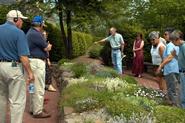
On a warm, sunny day made to order for a nature walk, more than 40
alumni and guests enjoyed a tour of Root Glen led by Ernest Williams,
the Leonard C. Ferguson Professor of Biology, during Reunion Weekend.
Williams, the author of The Nature Handbook (Oxford University Press), welcomed birders, butterfliers and gardeners to the hour-long walk through the Glen, including the Primrose Basin, Grant Garden and Hemlock Enclosure. He noted that people are visual beings and encouraged participants to look for patterns in nature, such as the spirals in the center of a daisy. Williams explained that the spiral patterns of plants are related to the Fibonacci numbers, numbers that lead to the most efficient packing of separate units around a point (The Fibonacci numbers form an infinite series in which each successive number is the sum of the previous two numbers) He pointed out unusual plants such as the alpine plant "pussytoes," and Washington Hawthornes, trees whose prickers defend it against enemies.
 Williams
told the group that the Root family bought the building adjacent to the
Glen in 1850 (now the Anderson-Connell Alumni Center) and then set
about planting trees, shrubs in the flowers in the cleared sheep
pasture which is now the formal garden. In 1971 the 7 ½ acre Root Glen
was given to the College by Grace Root.
Williams
told the group that the Root family bought the building adjacent to the
Glen in 1850 (now the Anderson-Connell Alumni Center) and then set
about planting trees, shrubs in the flowers in the cleared sheep
pasture which is now the formal garden. In 1971 the 7 ½ acre Root Glen
was given to the College by Grace Root.
Williams laced the tour with interesting facts and trivia and answered questions posed by the participants. He pointed out the 150-foot tall Tulip tree, noting its straight trunk, and told the group that the flower Queen Anne's Lace is the same species as the carrot. He said it was brought to the U.S. from Europe and does well here because it is missing its natural enemies. Williams showed the group by the largest Norway Spruce in the U.S. and encouraged alumni to come back and visit the Glen at a different time of year because it changes from week to week. The Root Glen contains some 65 species of trees, many different shrubs and hundreds of varieties of flowers.
Williams, the author of The Nature Handbook (Oxford University Press), welcomed birders, butterfliers and gardeners to the hour-long walk through the Glen, including the Primrose Basin, Grant Garden and Hemlock Enclosure. He noted that people are visual beings and encouraged participants to look for patterns in nature, such as the spirals in the center of a daisy. Williams explained that the spiral patterns of plants are related to the Fibonacci numbers, numbers that lead to the most efficient packing of separate units around a point (The Fibonacci numbers form an infinite series in which each successive number is the sum of the previous two numbers) He pointed out unusual plants such as the alpine plant "pussytoes," and Washington Hawthornes, trees whose prickers defend it against enemies.
 Williams
told the group that the Root family bought the building adjacent to the
Glen in 1850 (now the Anderson-Connell Alumni Center) and then set
about planting trees, shrubs in the flowers in the cleared sheep
pasture which is now the formal garden. In 1971 the 7 ½ acre Root Glen
was given to the College by Grace Root.
Williams
told the group that the Root family bought the building adjacent to the
Glen in 1850 (now the Anderson-Connell Alumni Center) and then set
about planting trees, shrubs in the flowers in the cleared sheep
pasture which is now the formal garden. In 1971 the 7 ½ acre Root Glen
was given to the College by Grace Root. Williams laced the tour with interesting facts and trivia and answered questions posed by the participants. He pointed out the 150-foot tall Tulip tree, noting its straight trunk, and told the group that the flower Queen Anne's Lace is the same species as the carrot. He said it was brought to the U.S. from Europe and does well here because it is missing its natural enemies. Williams showed the group by the largest Norway Spruce in the U.S. and encouraged alumni to come back and visit the Glen at a different time of year because it changes from week to week. The Root Glen contains some 65 species of trees, many different shrubs and hundreds of varieties of flowers.
Posted June 6, 2005
